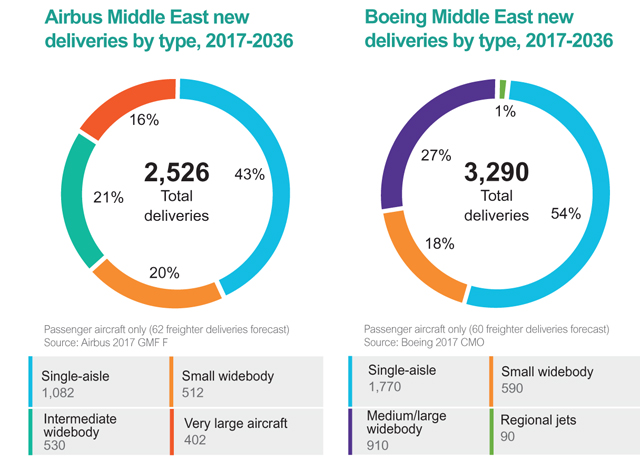The Middle East will continue to be a powerhouse for widebody airliner deliveries over the next 20 years, according to the latest forecasts from Airbus and Boeing. The region is also expected to show above-average growth.
Boeing’s latest current market outlook (CMO) predicts that global airliner demand will more than double over the next two decades, driving the size of the jet fleet to almost 47,000 units. This will result in the need for more than 41,000 new deliveries (including freighters), worth more than $6 trillion. The US manufacturer forecasts that GDP growth will average 3.5%/year, while traffic growth will typically rise by 5.6%/year.
For all the coverage from the Dubai air show visit our dedicated event page
Airbus, which uses slightly different definitions in its forecast (and excludes regional aircraft), sees demand over the next 20 years for some 34,170 passenger aircraft and 730 freighters, with a combined value of $5.3 trillion. It expects the region to enjoy 5.9%/year traffic growth, while GDP will expand at 3.4%/year.

Both manufacturers expect the Middle East airliner fleet will expand by more than 170% in the next two decades, to between 3,200 (Airbus) and 3,900 (Boeing – including freighters) aircraft. The two rivals concur on the size of the new freighter market – approximately 60 units – and that the region will be crucial for widebody airliner demand. Each manufacturer put the 20-year widebody market at almost 1,500 deliveries.
Overall, Middle East airlines are forecast to account for 7-8% of all airliner deliveries. Airbus puts total demand at 2,530 airliners worth $600 billion, while Boeing sees a market for 3,350 passenger and freighter aircraft worth $730 billion.
“About 80% of the world’s population lives within an 8h flight of the Gulf, allowing carriers in the Middle East to aggregate traffic at their hubs and offer one-stop service between many cities that would not otherwise enjoy such direct itineraries,” says Boeing. “Growth prospects for these connecting markets are strong.”
The key difference between the two forecasts is that Boeing is more bullish about demand for narrowbodies in the region than its rival, putting deliveries at 1,770 units versus 1,082. As a result, Airbus sees widebodies accounting for 57% of total demand in the region, while Boeing puts it slightly below 50%.
The high proportion of widebodies in the Middle East forecasts pushes the region’s share of overall demand by value (compared with share by unit) into double digits – 11% in the Airbus forecast and 12% in Boeing’s.
The region, which through Emirates, Qatar Airways and Etihad is by far the largest market for the A380 superjumbo, will account for almost one-third of the global market for what Airbus calls “very large aircraft” (VLA), taking 430 units (including 28 freighters).

However, Airbus vice-president of market strategy Bob Lange explains that the VLA category is defined as “450 seats and above”, so will potentially include the big Airbus and Boeing widebody twinjets with higher-density seating configurations, as well as the A380 and 747.
Airbus expects the region to see a vast increase in the number of “aviation mega-cities”. There are currently 58 such mega-cities globally, it says. “By 2036, there will be 95 mega-cities, catering for 98% of the world’s long-haul services. The five mega-cities existing today in the Middle East will more than double to 11 over the next 20 years.”
Boeing has eliminated the VLA category from its latest forecast and remains downbeat on the sector.
While it competes in the sector with the 747-8, Boeing is very pessimistic about future demand for passenger aircraft in the VLA sector, forecasting “just a handful going forward”, says Boeing’s vice-president marketing, Randy Tinseth. “We see a large airplane market that is so small that we do not believe Airbus will deliver the rest of the A380’s backlog.”
For all the coverage from the Dubai air show visit our dedicated event page
Source: Cirium Dashboard






















